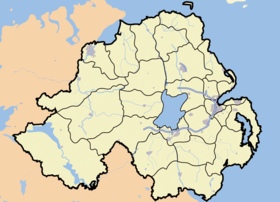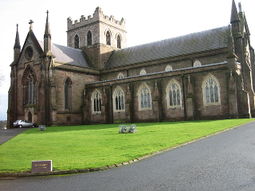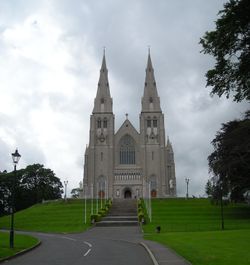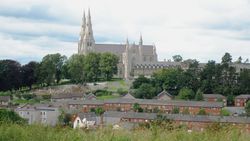Armagh
| Armagh | |
| Irish: Ard Mhacha | |
Thomas Street |
|
 Armagh
|
|
| Population | 14,590 (2001 Census) |
|---|---|
| Irish grid reference | |
| - Belfast | 33 miles |
| District | Armagh |
| County | County Armagh |
| Country | Northern Ireland |
| Sovereign state | United Kingdom |
| Post town | ARMAGH |
| Postcode district | BT60, BT61 |
| Dialling code | 028 |
| Police | Northern Ireland |
| Fire | Northern Ireland |
| Ambulance | Northern Ireland |
| EU Parliament | Northern Ireland |
| UK Parliament | Newry & Armagh |
| NI Assembly | Newry and Armagh |
| Website | http://www.armagh.gov.uk/ |
| List of places: UK • Northern Ireland • Armagh | |
Armagh (from Irish: Ard Mhacha meaning "Macha's height") is a large settlement in Northern Ireland, and the county town of County Armagh. It is an ancient site of worship for both Celtic paganism and Christianity. Although classed as a medium-sized town,[1] Armagh was granted city status by Queen Elizabeth II in 1994. Its population of 14,590 (2001 Census) makes it the least-populated city in both Northern Ireland and the island of Ireland.
Contents |
History
Foundation
Eamhain Mhacha (or Navan Fort) at the city's edge, is believed to have been used as an ancient pagan ritual or ceremonial site. According to Irish mythology it was once the capital of Ulster, until it was abandoned during the 1st century. The site was named after the goddess Macha, and as the settlement grew on the hills nearby, it was also named after the goddess — Ard Mhacha means "Macha's height". This name was later anglicised as Ardmagh,[2][3] which eventually became Armagh.
When Christianity spread to Ireland during the mid-400s, Armagh became the island's "ecclesiastical capital", as Saint Patrick established his principal church there. Saint Patrick decreed that only those educated in Armagh could spread the gospel. According to the Annals of the Four Masters, in the year 457:
Ard Mhacha was founded by Saint Patrick, it having been granted to him by Daire, son of Finnchadh, son of Eoghan, son of Niallan. Twelve men were appointed by him for building the town. He ordered them, in the first place, to erect an archbishop's city there, and a church for monks, for nuns, and for the other orders in general, for he perceived that it would be the head and chief of the churches of Ireland in general.
Medieval era
In 839 and 869, the monastery in Armagh was raided by Vikings. As with similar raids, their objective was simply to acquire valuables such as silver, which the churches and monasteries often kept.
The Book of Armagh came from the monastery. It is a 9th century Irish manuscript now held by the Library of Trinity College, Dublin (ms 52). It contains some of the oldest surviving specimens of Old Irish.

Brian Boru is believed to be buried in the cemetery of the St. Patrick's Church of Ireland cathedral. After having conquered the island during the 990s, he became High King of Ireland in 1002, until his death in 1014.
In 1189, John de Courcy, a Norman knight who had invaded Ulster in 1177, plundered Armagh.[4]
Modern era
Armagh has been an educational centre since the time of Saint Patrick, and thus it has been referred to as "the city of saints and scholars". The educational tradition continued with the foundation of the Royal School in 1608 and the Armagh Observatory in 1790. This was part of the Archbishop's plan to have a university founded in the city. This ambition was finally fulfilled, albeit briefly, in the 1990s when Queen's University of Belfast opened an outreach centre in the former hospital building.
Three brothers from Armagh died at the Battle of the Somme during World War One. None of the three has a known grave and all are commemorated on the Thiepval Memorial to the Missing. A fourth brother was wounded in the same attack.
On 14 January 1921, during the Irish War of Independence, a Royal Irish Constabulary (RIC) sergeant was assassinated by the Irish Republican Army (IRA) in Armagh. He was attacked with a grenade as he walked along Market Street and later died of his wounds.[5] On 4 September 1921, Michael Collins and Eoin O'Duffy addressed a large meeting in Armagh, which was attended by up to 10,000 people.[6]
The Troubles
For more information see The Troubles in Armagh, which includes a list of incidents in Armagh during the Troubles resulting in two or more fatalities.
2001 Census
The population of Armagh City on Census day (29 April 2001) was 14,590 people. The demographic characteristics of the people living in Armagh City was as follows:
- 25.1% were aged under 16 years;
- 17.5% were aged 60 and over;
- the average age was 35.2 years (NI average age 35.8 years);
- 48.1% of the population were male and 51.9% were female;
- 68.3% were from a Catholic Community Background;
- 30.2% were from a 'Protestant and Other Christian (including Christian related)' Community Background;
- 11.6% were born outside Northern Ireland; and
- 1.0% were from an ethnic group other than white.
For more details see: NI Neighbourhood Information Service
Buildings of note

Armagh is the site of two cathedrals, both on hills and both named after Saint Patrick. The Church of Ireland cathedral dates back to around 445. The present-day, post-Reformation, Roman Catholic cathedral was constructed during the latter half of the 1800s and features twin 64m spires, making it the tallest such structure in the county. Armagh is the only city in the world which is home to two cathedrals of the same name.
The city is home to the Armagh Observatory, founded in 1790, and to the Armagh Planetarium, established in 1968 to complement the research work of the Observatory. It has a Georgian area of heritage importance.
The palace of the Archbishop of Armagh is now the local council offices and, along with the archbishop's private chapel, is open to the public. The Palace Stables heritage centre is a reconstructed stable block dating from the 1700s, which was once part of the Archbishop's estate.
Among the city's chief glories is the public library on Abbey Street. Founded in 1771 by Archbishop Richard Robinson (later Lord Rokeby), using his own library as its nucleus, it is especially rich in 17th and 18th century English books, including Dean Jonathan Swift's own copy of the first edition of his Gulliver's Travels with his manuscript corrections.
Armagh Market House was built in 1815 as a two-storey five-bay building, and is currently used as a library.
 Armagh Prison |
Market House |
Armagh Public Library |
City centre regeneration

To combat the problem of a diminishing city centre and to address the concerns of local people, Armagh City and District Council decided to upgrade the surfaces and general appearance of the main shopping areas.
The scheme aims to deal with the many issues raised by the public and businesses over recent years. It will regenerate the centre of Armagh, transforming it into a high-quality pedestrian-friendly environment. The ineffective pedestrian area in Market Street will be opened officially to vehicles. The scheme will provide wider footpaths, pedestrian crossings and disabled parking throughout the city centre to improve safety and accessibility.
As well as these new street layouts the appearance of the city centre will be enhanced by new lighting, paving, seating, bins and greenery. The use of quality stone materials, public art projects and feature lighting will contribute to the overall effect and present the city’s famous architecture at its best. A shop frontage scheme will be launched toward the end of the street development project.
The scheme includes eleven streets: Market Street, Thomas Street, Ogle Street, Scotch Street, Dobbin Street, Dobbin Street Lane, Barrack Street, McCrum's Court, Upper English Street, Russell Street, Ogle Street and Linenhall Street.
The £5m Armagh City Centre Regeneration Scheme is funded by Armagh City and District Council, the Department of Social Development, the Roads Service and the Arts Council.
Administration
The city is run by Armagh City and District Council, headquartered in Armagh, which covers a larger area than just the city, but not the entire county. Together with part of the district of Newry and Mourne, it forms the Newry & Armagh constituency for elections to the Westminster Parliament and Northern Ireland Assembly. The Member of Parliament is Conor Murphy of Sinn Féin, who is a former Provisional Irish Republican Army prisoner and a member of the Sinn Féin negotiations team. He won the seat in the United Kingdom general election, 2005, after the retirement of long-serving SDLP MP Seamus Mallon.
The Southern Education and Library Board and the Southern Health and Social Services Board have their headquarters in the city, which has a long reputation as an administrative centre.
The secretariat of the North-South Ministerial Council is based in Armagh, and consists jointly of members of the civil services of both Northern Ireland and the Republic of Ireland.
Armagh is the seat of both the Church of Ireland Archbishop of Armagh and the Roman Catholic Archbishop of Armagh, both of whom hold the position of Primate of All Ireland for their respective denominations.
Education

Primary
- Armstrong Primary School
- Christian Brothers Primary School Armagh
- The Drelincourt Primary School[7]
- Drumhillery Primary School
- Mount St Catherine's Primary School
- St. Malachy's Primary School
- St. Patrick's Primary School
- Saints and Scholars Integrated Primary School
Post-primary
- City of Armagh High School
- The Royal School, Armagh
- St. Brigid's High School
- Saint Patrick's Grammar School, Armagh
- St Catherine's College Armagh
- Southern Regional College [8]
Transport
Armagh acquired rail links to Belfast in 1848 (Armagh railway station opened on 1 March 1848),[9] Monaghan in 1858, Newry in 1864 and Keady in 1909. The line to Newry was closed in 1933, and all other lines to Armagh were closed on 1 October 1957.[9]
The Armagh rail disaster, which killed 78 people, occurred on 12 June 1889 near Armagh on the line to Newry.
Sport
Gaelic football is popular in Armagh, its two major clubs being Armagh Harps[10] and Pearse Ógs.
The local Handball club is Eugene Quinn's, named after a deceased player from the Armagh area. The club's facilities are located in the Athletic Grounds.
In 2004 The Royal School, Armagh became only the second team in history to win both the schools' rugby and hockey cups in the same year.
The City of Armagh Rugby Club is based in the city.[11]
The Mall in Armagh has a long association with cricket, and is the location of the Armagh Cricket Club clubhouse. Famous captains in recent years include Chris Cairns, Andrew Rennie, David Bullick and Marco Elliott.[12]
Armagh City Football Club currently plays in the IFA Championship.
Town twinning
 Razgrad, Bulgaria (1995)
Razgrad, Bulgaria (1995)
See also
- Book of Armagh
- List of towns in Northern Ireland
- List of villages in Northern Ireland
- Market houses in Northern Ireland
- Maxwell, Ian. 2009. History and Guide Armagh. Nosush Publishing. ISBN 978 1 848 8951 7
References
- ↑ Northern Ireland Neighbourhood Information Service
- ↑ Placenames Database of Ireland (see archival records)
- ↑ Hill, George. The Fall of Irish Chiefs and Clans; The Conquest of Ireland. Irish Roots Cafe, 2004. Page 114.
- ↑ DeBreffny, D & Mott, G (1976). The Churches and Abbeys of Ireland. London: Thames & Hudson. pp. 60–61.
- ↑ http://www.dcu.ie/~foxs/irhist/january_1921.htm
- ↑ http://www.dcu.ie/~foxs/irhist/september_1921.htm
- ↑ The Drelincourt Primary School
- ↑ Armagh College of Further and Higher Education
- ↑ 9.0 9.1 "Armagh station". Railscot - Irish Railways. http://www.railscot.co.uk/Ireland/Irish_railways.pdf. Retrieved 8 September 2007.
- ↑ Armagh Harps Gaelic Football Club website
- ↑ City of Armagh Rugby Club website
- ↑ Armagh Cricket Club
External links
- Visit Armagh
- Armagh, City of at the Open Directory Project
- Online Guide to Armagh
- Armagh Observatory
- Armagh Planetarium
- Armagh Miniature Street Sculpture
- Mount St. Catherine's Primary School, Armagh
- St. Catherine's College, Armagh
- St. Patricks Grammar School, Armagh
- St. Brigid's High School, Armagh
- The Royal School, Armagh
- Lisanally Special School, Armagh
- Armagh Pipers' Club
- Armagh Franciscan Friary
- St Patrick's Cathedral
- Armagh Baptist Church
- Armagh City F.C.
- Armagh Public Library
- City of Armagh Rugby Club
- Armagh Harps Gaelic Football Club
- Armagh Free Presbyterian Church
- Armagh County Agricultural Show
- Woodford Hall
|
|||||||||||
|
||||||||||||||
|
||||||||||||||||||||